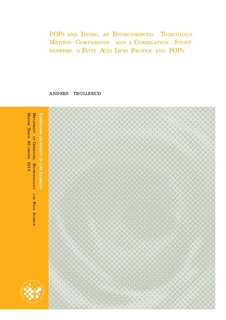| dc.contributor.author | Trollerud, Anders | |
| dc.date.accessioned | 2014-02-19T11:37:31Z | |
| dc.date.available | 2014-02-19T11:37:31Z | |
| dc.date.copyright | 2013 | |
| dc.date.issued | 2014-02-19 | |
| dc.identifier.uri | http://hdl.handle.net/11250/186561 | |
| dc.description.abstract | There are multiple goals in this study it is partly a method comparison study in environmental toxicology were different extraction methods and cleanup methods for quantitative determination of POPs (Persistent organic pollutants) will be discussed. There will also be a method validation part to this study were a new GPC column will be validated using an existing GPC cleanup method and using a standard reference material for chlorinated pesticides and comparing samples run over the GPC column with samples analyzed with existing methods for quantification of POPs. The last goal of the study will be to investigate if there is a correlation between the fatty acid lipid profile and POPs in fish samples.
4 different fish samples 3 cod liver samples and 1 salmon fillet were selected and they were homogenized together with sodium sulphate. These 4 different homogenates were the basis for all the samples. 8 samples (2 parallels of each fish) underwent cold column extraction and GPC/alumina oxide cleanup. 8 samples (2 parallels of each fish) underwent cold column extraction and sulfuric acid/silica cleanup. And 4 samples (1 of each fish) underwent ultrasonic bath (USB) extractions and GPC/alumina oxide cleanup. All the samples were analyzed for PCBs and chlorinated pesticides. Fatty acid lipid profiles were also determined by derivatisation of the fatty acids (FA) into fatty acid methyl esters (FAMEs) and analyzing them. The relative amounts were used to create the lipid profile.
Comparison between ultrasonic bath extraction and cold column extractions were done and the results of the cold column extractions showed better recoveries than the USB extractions, while an USB extraction gives more uncertainties in the method due to lower recoveries and some cross contaminations in the method.
Comparison of the sulfuric acid cleanup and the GPC cleanup showed that both methods give good results with good recoveries. But the acid cleanup degenerate and destroy some of the chlorinated pesticides makes the GPC cleanup method preferable in analysis of chlorinated pesticides.
The Waters Envirogel GPC cleanup column were used in different experiments and the results showed good and reproducible results with good recoveries. And a comparison with a certified standard reference material, 1588b, showed that the chlorinated pesticides were close to their given literature values.
There were created a lipid profile containing 8 fatty acids and their relative amounts, this were compared to calculated POPs from the same samples. The lipid profile and the calculated POPs were analyzed against each other using a PLS 2 algorithm. This analysis showed no clear correlation between the relative amounts of FA and any of the POPs, except for γ-HCH that were the only compound that might be effected by the different amounts of FA. | no_NO |
| dc.language.iso | eng | no_NO |
| dc.publisher | Norwegian University of Life Sciences, Ås | |
| dc.title | POPs and lipids : an environmental toxicology method comparison and a correlation study between a fatty acid lipid profile and POPs | no_NO |
| dc.type | Master thesis | no_NO |
| dc.subject.nsi | VDP::Mathematics and natural science: 400::Zoology and botany: 480::Ecotoxicology: 489 | no_NO |
| dc.subject.nsi | VDP::Agriculture and fishery disciplines: 900::Fisheries science: 920::Aquaculture: 922 | no_NO |
| dc.source.pagenumber | 30 | no_NO |
